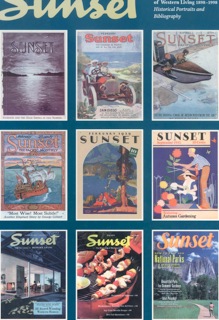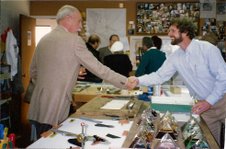[Image Below: “Sunset Magazine: A Century of Western Living (1898-1998: Historical Portraits and Bibliography. Great book.]

A new-old story by June Morrall
Laurence W. Lane knew why Sunset Magazine was failing. It was a publication about the West–but not for the West. And he was committed to that powerful vision when he arrived in San Francisco in 1928.
Success to the tall 38-year-old advertising director from Des Moines, Iowa, meant putting Sunset Magazine in most West Coast households. Lane was a pioneer in recognizing that the West differed from the rest of the country as he transformed the publication into the “The Magazine of Western Living.”
Sunset was for Western families, explained Laurence Lane’s son, Bill, who was the magazine’s publisher for many years. “Western lifestyle was unique, more adventuresome and daring.”
Sunset Magazine began as a 16-page pamphlet distributed free in the 1890s by its publisher, the Southern Pacific (SP) Railroad. The SP used it as a publicity tool to lure Easterners to the West Coast with colorful stories about California. But by 1914, with its promotional job completed, the SP returned to railroading and the magazine was sold to Woodhead, Field & Co.
Despite the publisher’s attempts to make it “The West’s Great National Magazine,” Sunset was failing when Laurence Lane bought it just months before the “Wall Street Crash”making his challenge to revitalize it even more daunting.
Lane had been the advertising director at Meredith Publishing Co. in Des Moines, publishers of Successful Farming and Better Homes and Gardens. That experience was vital for his task in California.
Lane immediately began reshaping Sunset. He kept the travel department and worked hard on the male readership, said Bill Lane, who has passed away since this interview.Research indicated that unlike their Eastern counterparts, a higher percentage of men in the West shopped for food, cooked, and gardened, areas featured by the reshaped magazine.
With more than 2 million families living in California, Oregon and Washington, Lane reasoned, a quarter of them belonged to a potential market for a regional Better Homes and Gardens type of magazine. The profile of Lane’s typical reader or subscriber was one who owned a home worth $5000 or more, above average at the time, and had an interest in home life, especially outdoor living.
Lane anticipated that he could best reach the homeowner with a Western how-to-do-it slant, a magazine specializing in Western food, gardens, homes, travel and crafts. That editorial formula became Sunset’s signature, and its key to success.
Early on, decisions were made to eliminate bylined articles and editors were encouraged to contribute and develop their ideas, writing the articles themselves. His first issue contained two-thirds more factual how-to-do-it information on Western living than ever before.
The how-to formula was carried over to all sections of the magazine. Even a backpacking trip to Yosemite was described with the same kind of detail found in the directions on a box of cake mix.
Sunset was a hit.
Although the Depression years were rough on Sunset, the magazine survived, and by 1936, Laurence Lane could confirm he was in the black.
Having grown up on a farm in Illinois, Lane loved the outdoors and he purchased a 500-acre horse ranch for $6000 in the Santa Cruz Mountains. Today Quail Hollow is a county park.
Sunset was almost entirely family owned, with Laurence Lane’s sons, Bill and Mel, engrossed in the daily operations. Lane’s wife, Ruth, a home economist, and president of the Palo Alto Garden Club, contributed her talents from the very beginning.
In the early 1950s, Laurence Lane, who had been publishing the magazine in San Francisco, acquired 7 acres of land along San Francisquito Creek in Menlo Park for Sunset’s present-day headquarters.
Renowned landscape architect Thomas Church designed the oak tree-studded gardens surrounding the distinctive ranch house office building, designed by Cliff May, at Middlefield and Willow Roads.
The Lane boys, Bill and Mel, became more involved. Bill was publisher between 1960 and 1985, then was appointed Ambassador-at-Large, first to Japan and later to Australia; he resumed his role as publisher in 1989.
Mel headed up the separate book publishing company, echoing the how-to-do-it theme in the magazine.
Under the Lane family’s management, the magazine pushed forward, focusing on the latest advances in gardening, travel, home building and publishing new food recipes first tested in Sunset’s fully equipped modern kitchens.
Sunset was always in the forefront. It was apparent that people gardened differently in San Diego and Seattle, leading to the introduction of three different editions of the magazine.
“We published articles on “ecotourism” before the word was coined, working with travel agents to seek out-of-the-way places,” said Bill Lane.
And when a proposed freeway running from Menlo Park to the Coastside, threatened Sunset’s Willow Road headquarters, the Lane family searched for a new location, finally settling on 3000 Sand Hill Road.

The freeway did not materialize, but Lane says they were “pioneers on San Hill Road,” which in 1999 housed some of the most expensive office space in the nation.
When Laurence W. Lane died in 1967 at age 76, Sunset Magazine , with four zoned editions, reported a circulation of more than 850,000.
In 1990, Time-Warner acquired Sunset, and the venerable publication celebrated its centennial in 1998.
———
A new-old story by June Morrall
———————————
Story by Peter Adams

